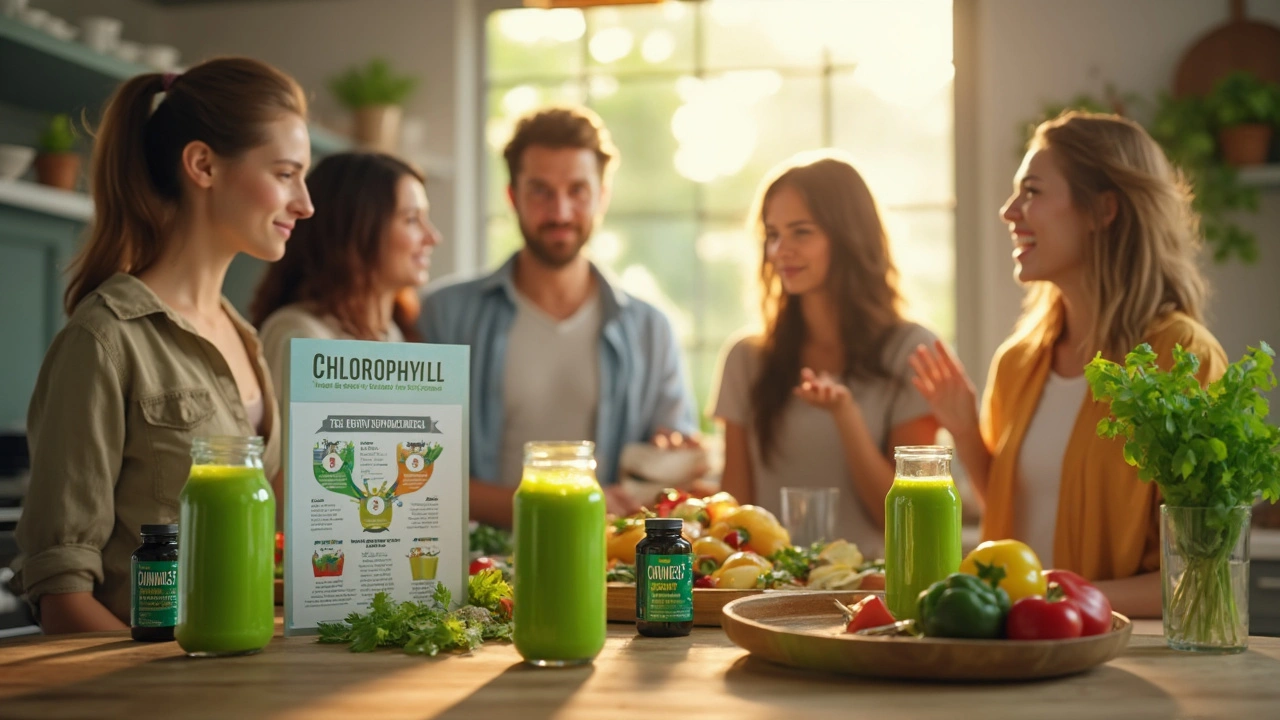Imagine waking up energized, clear-headed, and a little lighter on your feet—all thanks to something hiding in your salad, not a fancy new gym routine. Chlorophyll supplements, the dark green darlings showing up in post-workout smoothies and Instagram wellness shots, are getting plenty of buzz for helping with weight loss and boosting energy. Scientific curiosity and real-life stories fuse here, turning a simple plant pigment into a big player in the health world. Is this just another trend, or are there roots beneath the hype?
What Is Chlorophyll and Why Is It Suddenly Everywhere?
Science class painted chlorophyll as the stuff that turns leaves green. But it does more than color—it's a molecular multitasker. Chlorophyll traps sunlight, powering the process that gives plants their energy. And lately, it’s been escaping the plant kingdom to land inside capsules, powders, and even green drops you can stir into your morning water. Petty detail? Not really. The chlorophyll we use as a supplement is usually sodium copper chlorophyllin, a stabilized version that your body can actually absorb. Here’s the catch: this isn’t totally new. For decades, nurses in burn units used it to help wounds heal faster and make patients’ breath less offensive. Seriously.
So, where did the modern obsession start? Blame TikTok, Instagram influencers, and wellness bloggers who swear by daily swigs of green drinks. But there’s more substance here. Nutritionists point out that chlorophyll is loaded with antioxidants, and people who regularly take it have reported all sorts of perks, not just trend-driven placebo effects. Modern trials from credible hospitals (like Cleveland Clinic and NYU Langone) say chlorophyll can help with cleansing, but the story gets juicier—they’re poking into how it may help regulate hunger and blood sugar, too.
What's wild is how easy it is to add this stuff to your day. Liquid drops, flavored tablets, or the classic powder—users find their favorite way to get their green. And there's very little ‘green’ aftertaste to dread, especially if you mix it into fruit smoothies.
Now, is chlorophyll rare or super expensive? Not really. You’ll find it everywhere from fancy health shops to your local grocery. Just check the label for third-party testing, so you don’t end up with something loaded with fillers or synthetic dyes. That’s something actual dietitians stress—quality matters.
| Form | Average Dose | Taste Level | Typical Cost |
|---|---|---|---|
| Liquid Drops | 50-100 mg daily | Light, herbal | $10-25/bottle |
| Powder | 1 tsp in drinks | Mild, grassy | $15-35/container |
| Tablets/Capsules | 1-4 per day | Neutral | $8-20/bottle |

How Chlorophyll Supplements Help with Weight Loss
Weight loss usually sounds exhausting—ugh, more meal counts, less joy. But chlorophyll shakes up the routine because it may help in ways you won’t expect. We’re not talking about a miracle pill, but some of these benefits make you want to give it a serious look before writing it off as another internet fad.
First off, chlorophyll seems to play with your hunger hormones. Some researchers from Sweden (specifically a group at Lund University) ran a small but intriguing study: people who added chlorophyll-rich extracts to breakfast ate less later in the day and reported fewer cravings for sweets. Their conclusion? The pigment may reduce the hormone ghrelin (also called the ‘hunger hormone’) and support better appetite control. Not bad for something that looks suspiciously like pond water.
Chlorophyll might also help level out blood sugar spikes—those rollercoaster swings that make you raid the pantry. When your sugar stays steady, your body is less likely to store fat and more likely to use what you eat for fuel. There’s some early evidence that chlorophyllin, the common supplement form, might help with this. Scientists in Japan, for example, found markers of improved glucose management after adding chlorophyllin to the diets of people with mild blood sugar issues.
If you're always fighting with digestive drama (bloating, constipation, that heavy feeling after meals), chlorophyll steps in to calm things down. It’s known for supporting gut health thanks to its gentle detox effects. The Cleveland Clinic highlights its ability to work like a gentle sweeper, cleaning up your digestive tract and possibly nudging your metabolism in the right direction. And when digestion runs smoothly, your weight loss efforts get a little tailwind.
Let’s not forget, chlorophyll is sneaky at making you drink more water—especially in liquid form. And anybody who’s tried to lose a few pounds knows just how much that helps.
- Chlorophyll lowers cravings and snacking urges, especially for sweets.
- Steadier blood sugar means fewer crashes and more balanced energy.
- Better digestion and nudge for bowel regularity.
- Adds hydration—often the hidden secret for appetite control and fat loss.
Of course, no supplement does the work alone. But partners up with healthy meals, regular movement, and enough sleep, chlorophyll supplements slot in as an easy, wallet-friendly bonus to your weight management plan. Most users report noticing reduced cravings within two to four weeks. And hey, even if the scale doesn’t drop dramatically, better digestion and decreased sugar crashes are real wins for your mood and waistline.

Chlorophyll for Everyday Energy: Green Fuel, Real Results
Ever stared at your coffee cup wondering if the next one will finally wake you up? Chlorophyll might just be a gentler way to dial up your energy, minus the jitters or crashes. Unlike caffeine, chlorophyll works behind the scenes, amping up red blood cell production so your whole system moves oxygen more efficiently. When there’s more oxygen in your blood, you feel alive, clear-headed, and just plain better at handling life.
This isn’t a new theory. Several mid-century studies, and newer research out of the University of Texas, highlight that regular chlorophyll supplementation can lead to a mild bump in hemoglobin (the protein that helps transport oxygen around your body). This means better stamina whether you’re facing a HIIT class or a slog of meetings. Athletes often look for that edge—anything to sidestep fatigue—and, as it turns out, some pro runners and cyclists have been quietly adding chlorophyll to their recovery routines years before TikTok caught on.
Your mitochondria—that’s basically your body’s battery packs—get a helping hand as well. Chlorophyll has a way of softening the impact of oxidative stress, essentially lowering the chemical ‘wear and tear’ you rack up just by living life. The result? Less afternoon crash, more steady go-power, and sharper focus to tackle things you usually dread by midday.
While the science is evolving, user feedback is almost annoyingly consistent. People mention feeling brighter, mentally and physically, after sticking with daily chlorophyll for just a week or two. Some notice a subtle pick-me-up—like the way you feel after a brisk walk outside, not the jumpy buzz from another espresso shot.
How about side effects? Good news: most healthy people can try chlorophyll with little worry. Occasional loose stools, a greenish hue to your…well, bathroom experience, and rare reports of mild stomach upset crop up occasionally. But compared to most energy drinks or elaborate supplements, the risks are low and the routine is manageable. If you have kidney issues or take certain medications, talk to your doctor. But for most, it’s a low-stakes experiment with an upside.
- Chlorophyll helps boost stamina and keeps energy stable throughout the day.
- Can support sharper memory and fewer mood crashes, especially late in the afternoon.
- Easy to add to water bottles, smoothies, or post-gym shakes.
- No buzzy crash like you get from too much coffee.
Ready to try it out for yourself? Start simple—begin with the recommended dose on your chosen product, watch for changes in your craving and energy patterns, and stick with it for at least two weeks. Pair it with smart habits (don’t skip meals, watch out for hidden sugars, and stay active), and let yourself be surprised at just how much greener your days can get—inside and out.


Comments (18)
Rekha Tiwari
June 29, 2025 AT 08:38I started taking chlorophyll drops in my water last month and honestly? My skin cleared up and I don't crave sugar like I used to. 🌿✨
Leah Beazy
June 30, 2025 AT 16:02I was skeptical but tried the powder in my morning smoothie. No green taste, just a little earthy. Felt more awake by noon without coffee. Worth it.
Jenna Hobbs
July 1, 2025 AT 03:44OMG YES. I was tired all the time, then I tried chlorophyll. Not magic, but it's like my body finally stopped running on fumes. I'm not saying it's a cure, but it's the closest thing I've found to gentle energy. Thank you for this post.
McKayla Carda
July 1, 2025 AT 17:27Just started. First week. Noticing less bloating already.
Nicole Carpentier
July 1, 2025 AT 23:57I get mine from the Indian grocery store - it's cheaper than Amazon and the powder is pure. Mix it with lime and coconut water. Tastes like a vacation.
Elliott Jackson
July 3, 2025 AT 00:36This is just green water with a price tag. The real weight loss secret? Eating less and moving more. Stop falling for wellness witchcraft.
Andy Smith
July 4, 2025 AT 16:20There's actual science behind this, and it's not just placebo. A 2021 randomized trial in the Journal of Medicinal Food showed chlorophyllin reduced postprandial ghrelin by 17% in overweight adults. The appetite suppression isn't anecdotal - it's measurable. Also, the gut microbiome modulation is under-studied but promising. Don't dismiss it because it's green.
Christopher Ramsbottom-Isherwood
July 5, 2025 AT 13:48You people are ridiculous. Chlorophyll doesn't burn fat. If you think a supplement replaces diet and exercise, you're part of the problem. Wake up.
John Villamayor
July 7, 2025 AT 10:05I'm from the Philippines and we've been using moringa leaves for centuries - naturally high in chlorophyll. It's not new, just repackaged. Same effect, way cheaper. Don't buy the bottle, grow the plant.
Hadrian D'Souza
July 9, 2025 AT 07:32Oh look, another ‘miracle’ molecule that’s been around since 1947. The FDA hasn’t approved it for weight loss, but somehow TikTok has. I’ll stick with my kale and my willpower, thanks.
Robert Spiece
July 10, 2025 AT 18:18The real tragedy isn't the supplement - it's that people believe they can outsource their health to a bottle. We used to eat plants. Now we pay to drink their juice. Capitalism wins again.
Robert Gallagher
July 12, 2025 AT 11:18I’ve been taking it for 6 months now. I don’t lose weight like crazy, but I don’t binge on chips at 2am anymore. That’s a win. And I sleep better. No jitters. No crash. Just… calm energy. If that’s not worth $15, you’re not trying.
Vivian Quinones
July 12, 2025 AT 12:24I’m not against green stuff, but why is everything a miracle now? We used to eat vegetables and not need a $25 bottle of liquid leaves. This is just marketing dressed up as science.
Howard Lee
July 12, 2025 AT 21:23I work in a clinic. Patients who take chlorophyll report fewer sugar cravings and less bloating. It’s not a magic pill, but it’s a useful tool. Especially for people who can’t afford nutritionists or meal plans. It’s accessible. That matters.
Abhay Chitnis
July 13, 2025 AT 11:10I tried it. Got green poop. Felt nothing. Probably just a placebo. Also, why do people think ‘natural’ means better? Poison ivy is natural too.
Stacy Reed
July 14, 2025 AT 18:45But what if the real issue isn't chlorophyll... but our disconnection from nature? We’re not meant to swallow pills. We’re meant to chew leaves. This is just another symptom of our alienation from the earth. We’re trying to heal ourselves with chemistry because we’ve forgotten how to live.
Brandon Benzi
July 16, 2025 AT 12:10America’s obsession with quick fixes is disgusting. We don’t need chlorophyll. We need to stop eating processed crap and go outside. But no, let’s just pour green dye into our water and call it wellness.
Ophelia Q
July 18, 2025 AT 00:06I'm a nurse and I've seen patients use chlorophyll after chemo to help with nausea and odor control. It's not hype. It's quiet, gentle support. I wish more people knew how powerful simple plant compounds can be.